As speech therapists, we know that initial F words can be challenging for some individuals to produce correctly. It is common for children and adults with speech sound disorders to struggle with these sounds, which can impact their ability to communicate effectively. This blog post has over 105 initial f words that will help strengthen your child or student’s /f/ sound. We will explore the topic of initial f words in speech therapy and provide techniques and tools for teaching and practicing these sounds.
The F sound is a fricative sound that requires the lips and teeth to come together to create a small opening for air to pass through. This sound is often challenging for individuals with speech sound disorders, and it can impact their ability to produce words and communicate effectively.
As speech therapists, it is our role to help individuals overcome these challenges and develop strong communication skills.
Key Takeaways:
- Initial F words articulation lists in initial medial final word positions.
- Techniques and tools for teaching and practicing initial f words can help individuals improve their communication skills.
- Speech therapists play a critical role in helping individuals overcome challenges with initial f words and develop strong communication skills.
Correct Production
Let’s review how to make the correct sound production of the f sound in the English language.
- Teeth: The /f/ sound is made in the front of the mouth. The first thing to do is to place your upper front teeth on top of your bottom lip.
- Lip Position: Again the f sound is made by placing the lower lip under the top teeth.
- Voice: This sound is an unvoiced sound. You can tell that you’re vibrating your vocal folds by placing your hand on your larynx (where an adam apple is located) and feel for a vibration. This is the only difference between the v and f sound.
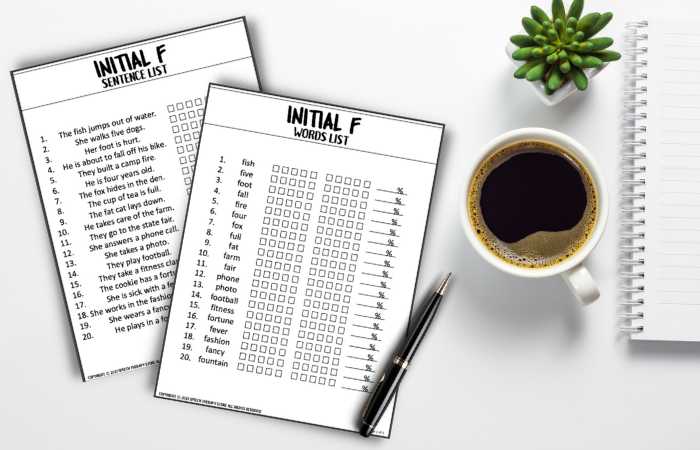
Target Words
Here’s a list of the f initial words for Speech-Language Pathologists or parents to use in their therapy sessions to work on your student or child’s target sound.
- For Example Targeted Words: fan, fit face, fun, food, four, fat, funny, feet, fill, fin, feed, foot, fear, fire, fine, fancy
See full list of words, phrases, and sentences below.
Be sure to grab my one page freebie of single words of initial f speech sounds below. Simply scroll to the bottom of this post and grab your free copy!

Word Positions: Initial F Words Speech Therapy
Initial Position of Words
The initial sound of f is at the beginning of a word. For example, the initial word position of the initial f sound could be “fine” or “fake”.
Medial Position of Words
Some words have the f sound in the medial position of a word, such as “breakfast”, “muffin”, and “office”.
Final Positions of Words
Final f words are when the target sound is at the end of a word. For example, “laugh” or “beef”.
Techniques for Teaching Initial F Words
When it comes to speech therapy, teaching initial F words can be a challenge. However, there are several techniques that we can use to help our clients improve their production of these sounds.
In this section, we will discuss three effective techniques for teaching initial F words: using minimal pairs, auditory discrimination, and utilizing a tactile cue.
Using Minimal Pairs
One effective technique for teaching initial F words is to use minimal pairs. Minimal pairs are two words that differ by only one sound, such as “fat” and “pat.”
By using minimal pairs, we can help our clients distinguish between the correct and incorrect production of the F sound.
We can also help them to understand how changing the sound can change the meaning of the word.
Auditory Discrimination
Another technique for teaching initial F words is to teach auditory discrimination. This means helping our clients to hear the difference between the correct and incorrect production of the F sound.
We can do this by having them listen to recordings of the correct and incorrect productions of the sound, and asking them to identify which one is correct.
We can also have them practice producing the sound while listening to themselves through headphones, which can help them to better hear the sound they are producing.
Tactile Cue: Bottom Lip to Top Teeth
In addition, we can use a tactile cue to help our clients improve their production of the F sound.
One effective tactile cue is to have them place their bottom lip on their top teeth, and then blow air out through their mouth. This can help them to produce the F sound correctly.
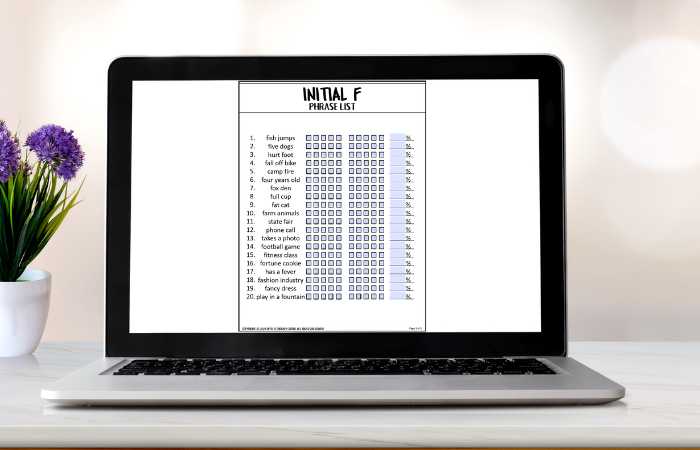
Initial F Words at Word Level
Some ways to practice include having your child or student say each initial /f/ word one by one as they go through a list.
Using a dot marker can also be a fun way to practice having your child put a dot under each initial f sound.
In addition, I’ve compiled an easy-to-download one page overview of initial f sounds below. Simply scroll down to the bottom of this post and download your free copy.
- 1 Syllable: fish, five, foot, film, fire, faith, for, food, fall, fun, face, fear, field, four, far, full, fox, form, fat, fair, fate, fast, farm, fine, fork, fight, fin, fool, ford, force, feet, fan, first, fix, fur, fern, fact, fame, fail, fence, fudge, fog, feet, phone
- 2 Syllable: future, fifty, fourteen, father, forty, fifteen, football, forest, forum, failure, forward, famous, fitness, function, fortune, fever, fashion, funny, finger, faking, fountain, fairness, final, feeling, figure, fancy, fingers, fastest, fable, focus, forget, fearless, filters, feelings, fallen, feather, famine, photo, physics, phonics
- 3 Syllable: family, favorite, feminine, forever, funeral, fiesta, fantasy, finally, fabulous, formula, fireworks
- 4 Syllable: forgiveness, February, Filipino, photography, photogenic, philosophy, phenomenon, photographer, physician
Practice in Flash Card Mode Right Here from Your Computer!
Initial F Words Speech Therapy
| 1 Syllable | 2 Syllables |
|---|---|
| fish | future |
| five | fifty |
| foot | fourteen |
| film | famine |
| fire | father |
| faith | forty |
| for | fifteen |
| food | football |
| fall | forest |
| fun | forum |
| face | failure |
| fear | forward |
| field | famous |
| four | fitness |
| far | function |
| full | fortune |
| fox | fever |
| form | fashion |
| fat | funny |
| fair | finger |
| fate | faking |
| fast | fountain |
| farm | fairness |
| fine | final |
| fork | feeling |
| fight | figure |
| fin | fancy |
| fool | fingers |
| ford | fastest |
| force | fable |
| feet | focus |
| fan | forget |
| first | fearless |
| fix | filter |
| fur | feelings |
| fern | fallen |
| fact | feather |
| fame | photo |
| phone | physics |
| fail | phonics |
| fence | |
| fudge | |
| fog | |
| feet |
| 3 Syllables | 4 Syllables |
|---|---|
| family | forgiveness |
| favorite | February |
| feminine | Filipino |
| forever | photography |
| funeral | photogenic |
| fiesta | philosophy |
| fantasy | phenomenon |
| finally | photographer |
| fabulous | physician |
| formula | |
| fireworks |

Short Sentences or Phrases
When working on initial f sound production, it’s important to work on short phrases once your child or student has mastered the sound at the word level at or near 80% or higher accuracy.
Here is a list of initial f word phrases to try:
Initial F Words Speech Therapy in Phrases
| 1 Syllable | 2 Syllables |
|---|---|
| fish jumped | future is clear |
| five dogs | fifty days |
| hurt foot | fourteen chickens |
| developed film | his father |
| fire burned | forty years old |
| had faith | fifteen kids |
| for you | football game |
| ordered food | walk through the forest |
| fall off the bike | open forum |
| fun time | is not a failure |
| face smiles | go forward |
| fear of spiders | famous for singing |
| fog rolls in | fitness test |
| field day | invited to a function |
| four years old | fortune cookie |
| far away | high fever |
| full cup | fashion industry |
| fox sleeps | funny guy |
| form a circle | finger hurts |
| fat cat | faking it |
| go to a fair | water fountain |
| his fate | strive for fairness |
| fast car | final test |
| farm animals | feeling sick |
| feel fine | figure skating |
| fork and spoon | fancy dress |
| siblings fight | fastest car |
| fin of a fish | tells a fable |
| not a fool | focus on her lesson |
| ford bronco | she won’t forget |
| force of nature | feels fearless |
| two feet | water filter |
| ceiling fan | hurt her feelings |
| first in line | fallen off her scooter |
| fix the roof | bird feather |
| dogs fur | famine sweeps across the land |
| fern grows | takes a photo |
| is a fact | studies physics |
| fame got to him | learns his phonics |
| lost her phone | |
| fail the test | |
| building a fence | |
| eating fudge |
| 3 Syllables | 4 Syllables |
|---|---|
| my family | gives forgiveness |
| favorite color | February 14th |
| feminine shirt | Filipino neighbor |
| promised forever | studies photography |
| goes to a funeral | photogenic smile |
| throw a fiesta | studies philosophy |
| fantasy football team | first phenomenon |
| finally made it | is a photographer |
| fabulous idea | call the physician |
| math formula | |
| fireworks show |
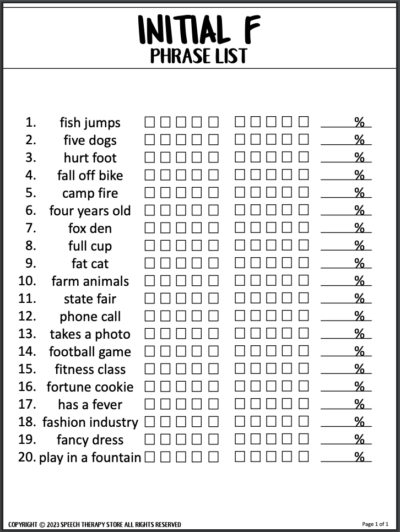
Sentence Level: Initial F Words Speech Therapy
The next step after working at the word and phrase levels is to work on the initial f sound at the sentence level.
For example, you could give your child or student a list of sentences to read aloud while they work on their initial f sound.
Another idea would be to give your child or student pictures with their initial f sound in them and then have them create a sentence about those pictures.
Below is a list of sentences to use with your child or students.
Initial F Words Speech Therapy in Sentences
| 1 Syllable | 2 Syllables |
|---|---|
| The fish jumped out of the water. | Her future is clear. |
| She walks five dogs. | I will be back in fifty days. |
| He hurt his foot. | I have fourteen chickens. |
| He developed the film. | He looks just like his father. |
| The fire burned brightly. | She is forty years old. |
| She had faith it would work out. | There are fifteen kids in the class. |
| He made a picture for you. | They went to a football game. |
| I ordered food at the deli. | We walk through the forest. |
| I might fall off my bike. | This is an open forum. |
| They had a fun time. | She is not a failure. |
| His face smiles when he sees me. | The cars go forward. |
| She has a fear of spiders. | He is famous for singing. |
| She lost her phone. | She goes to a fitness class. |
| They host a field day. | We are invited to a function. |
| She is four years old. | I read my fortune cookie. |
| They moved far away. | He is sick with a high fever. |
| She has a full cup of tea. | She works in the fashion industry. |
| The fox sleeps in its den. | He is a funny guy. |
| They form a circle. | She creates flawless art. |
| She has a fat cat. | My finger hurts. |
| We all go to a fair. | He seems to be faking it. |
| He chose his fate. | They play in the water fountain. |
| That is a fast car. | They strive for fairness. |
| She takes care of the farm animals. | This is his final test. |
| I feel fine. | She is feeling sick. |
| I put a fork and spoon on the table. | She is a figure skater. |
| The siblings sometimes fight. | She wears a fancy dress. |
| I saw the fin of a fish. | He has the fastest car. |
| She is not a fool. | He tells a fable. |
| He drives a Ford Bronco. | She will focus on her lesson. |
| A hurricane is a force of nature. | She won’t forget. |
| He is two feet tall. | He feels fearless. |
| He installed a ceiling fan. | She uses a water filter. |
| She goes to the first line. | That hurt her feelings. |
| We need to fix the roof. | She has fallen off her scooter. |
| The dog’s fur is on her leggings. | There is a bird feather on the ground. |
| The ferns grow thick here. | The famine swept across the land. |
| That is a fact. | He took a photo. |
| The fame got to him. | She studies physics. |
| The fog rolls in. | He learns his phonics. |
| She did not fail the test. | |
| They are building a fence. | |
| I am eating fudge. |
| 3 Syllables | 4 Syllables |
|---|---|
| My family eats dinner together. | He gives forgiveness. |
| Pink is her favorite color. | February 14th is Valentine’s Day. |
| She wears a feminine shirt. | My Filipino neighbor is so kind. |
| He promised forever to her. | He studies photography. |
| We went to a funeral. | He has a photogenic smile. |
| She throws a fiesta. | He studies philosophy. |
| My fantasy football team is losing. | This is the first phenomenon. |
| We finally made it. | She is a photographer. |
| She had a fabulous idea. | They call the physician. |
| He works on a math formula. | |
| They watch a fireworks show. |
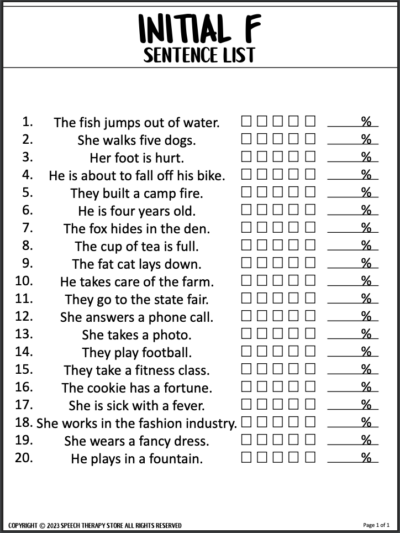
SEE ALSO: 21 Best Reinforcement Games for Speech Therapy
Initial F Tools and Activities for Practice
When it comes to initial F speech therapy practice, we have found that using a variety of tools and activities can help keep our clients engaged and motivated throughout the process.
Below I’ve outlined activities that I’ve found to be particularly helpful: word lists, Boom Cards, and interactive whiteboard activities.

Word Lists
Word lists are a classic tool for speech therapy, and they can be particularly effective when working on initial f words.
- At Home Word Lists for Articulation and Phonology for SLPs – Freebie by Natalie Snyders is a comprehensive word list set for initial f articulation. It is easy, clear and ready to print!
- Word Lists for Speech Therapy By Speecheez is another great list of initial f words that are easily pared with books or can but cut and laminated for re-use!
- FREE F Sound Articulation Worksheets for Speech Therapy by Playing Speech is a great resource that is ready to print and go! These worksheets have great initial F words and prompts students to trace/say or cut/glue as they practice initial F articulation.
Boom Cards
Another tool that we have found to be effective for teaching initial f words during speech therapy are Boom Cards.
These interactive digital flashcards are a fun and engaging way to practice f words. Boom Cards can include a variety of different activities, such as matching games, fill-in-the-blank exercises, and more. This helps keep things interesting and challenging for our clients, and it also ensures that they are getting plenty of practice with a variety of different activities.
- F Articulation Balloon Pop Game: Initial, Medial, Final Boom Cards + Real Game by jenn-slp is an interactive boom card set that prompts students to pop balloons as they practice f articulation.
- Free Falling Leaves Interactive Articulation Boom Cards by Thumb Bunny Speech is a fun, fall themed boom card set that has students practice f articulation!
- Articulation BOOM CARDS: Initial F | Mermaid Search & Say FREEBIE by Speechie Pals is a great boom card set that has students look for their mermaid while picking initial f objects. This set is engaging and fun!
SEE ALSO: Free Articulation Games for Speech Therapy

Interactive Whiteboard Activities
Interactive whiteboard activities are another great tool for working on initial F words in speech therapy. We like to use interactive whiteboards to create engaging activities that help our clients practice their F words in a fun and interactive way. Some of our favorite activities include word searches, crossword puzzles, and matching games.
One of the great things about interactive whiteboard activities is that they can be customized to meet the needs of each individual client. For example, we can adjust the difficulty level of the activity to match the client’s skill level, or we can focus on specific F words that the client is struggling with. This helps ensure that each client is getting the practice they need to make progress in their speech therapy.
- How To Use Jamboard by Speech Therapy Store is a great tutorial on how to use Jamboard interactively and individually for your students! Jamboard is a great tool for SLPs!
Working with Younger Children
Here are some games, toys, and other fun activities to keep the child interested and motivated.
- Articulation I SPY Page– /f/- FREEBIE by Taco abou it- Speech Fun is a very engaging and fun game for younger children. It is a quick play with multiple initial f targets!
- F-words Bingo Dab by the Speechie Lady is a fun game for younger students to play that prompts them to play bingo with dot markers while practicing their initial f sounds!
- Cut and Glue Speech Therapy – Lemonade Themed Free Sample by Keeping Speech Simple is a fun activity that prompts students to cut out the target F sound on lemons and ice and glue it into a pitcher to make lemonade!

Addressing Challenges in Speech Therapy
Working with Younger Children
When working with younger children in speech therapy, we understand that their attention span may be limited, and they may not be able to sit still for long periods. Therefore, we make sure to keep the sessions short and engaging. We use games, toys, and other fun activities to keep the child interested and motivated. We also use simple language and clear instructions to make sure the child understands what we want them to do.
Another challenge when working with younger children is getting them to practice at home. We understand that parents may have busy schedules and may not have a lot of time to work with their child on speech therapy exercises. Therefore, we provide parents with simple and easy-to-follow instructions and activities that they can do with their child at home. We also encourage parents to make speech therapy a fun and positive experience for their child.
Home Practice for Speech Therapy
Home practice is a great way to reinforce the skills learned during speech therapy sessions. As speech therapists, we recommend that our clients practice at home to maximize the effectiveness of therapy. In this section, we will discuss the benefits of home practice and provide some tips for incorporating it into your speech therapy routine.
Benefits of Home Practice
Home practice allows clients to continue working on their speech skills outside of therapy sessions. It provides an opportunity to practice in a comfortable and familiar environment, which can help to reduce anxiety and increase confidence. Regular home practice can also help to speed up progress and improve overall outcomes.
Tips for Home Practice
When incorporating home practice into your speech therapy routine, it is important to set realistic goals and expectations. Here are some tips to help you get started:
- Schedule regular practice sessions: Set aside a specific time each day or week for practice. This will help to establish a routine and make it easier to stick to.
- Use materials provided by your speech therapist: Your therapist will provide you with exercises and materials to practice at home. Make sure to use these resources as they are specifically tailored to your needs.
- Practice in a quiet and distraction-free environment: Find a quiet place to practice where you can focus without distractions.
- Record yourself: Use a recording device to listen to yourself practice. This can help you identify areas for improvement and track your progress over time.
- Practice with a partner: Practicing with a partner can be a fun and effective way to reinforce skills. Ask a family member or friend to practice with you.
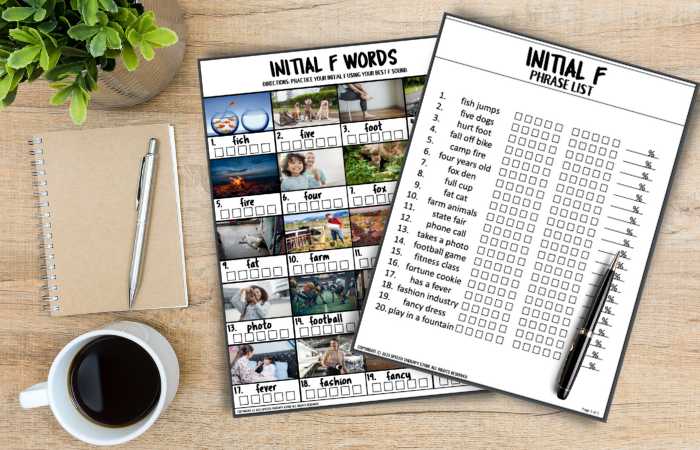
Conclusion
Incorporating home practice into your speech therapy routine can be a great way to reinforce skills learned during therapy sessions.
By setting realistic goals and expectations, using materials provided by your therapist, practicing in a quiet environment, recording yourself, and practicing with a partner, you can maximize the effectiveness of therapy and improve overall outcomes.
SEE ALSO: 279+ Free Speech Therapy Digital Materials
When a Child Has a Hard Time
Sometimes, a child may have a hard time with speech therapy. They may struggle to make progress, or they may become frustrated and lose motivation. In these cases, we take a step back and re-evaluate the child’s goals and progress. We may adjust our approach or try different techniques to help the child make progress.
It’s also important to remember that progress may be slow and gradual. We don’t expect a child to make significant improvements overnight. We celebrate small victories and encourage the child to keep working towards their goals.
If a child is struggling with speech therapy, we also make sure to communicate with the parents and other professionals involved in the child’s care. We work together to come up with a plan that will best support the child’s needs and help them make progress.
Overall, addressing challenges in speech therapy requires patience, flexibility, and a willingness to adapt our approach. We understand that every child is unique and may require different strategies to help them succeed. By working together with the child, their parents, and other professionals, we can help them reach their full potential.
Need Different Phonemes or Sounds?
You won’t want to miss out on my complete growing list of different target speech sounds from my articulation word lists helpful for students with an articulation disorder or phonological disorder.
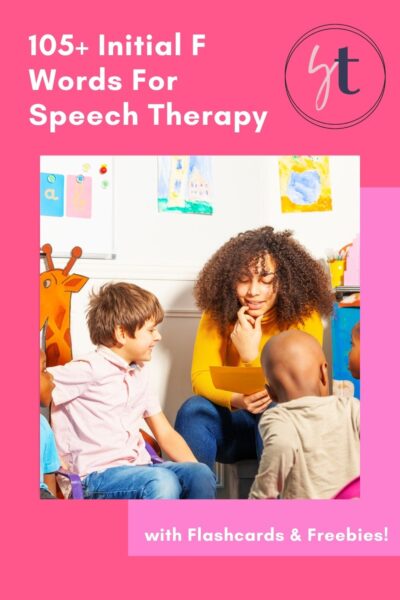
Frequently Asked Questions
What are some common initial F words used in speech therapy?
Some of the common initial F words used in speech therapy include “fan,” “fun,” “fish,” “four,” and “fox.”
What techniques are used to help children with initial F sound production?
Speech therapists use a variety of techniques to help children with initial F sound production, including articulation drills, auditory discrimination, and tactile cues. These techniques may involve repetition, modeling, and feedback to help children learn to produce the F sound correctly.
How can parents support their child’s progress in initial F sound therapy?
Parents can support their child’s progress in initial F sound therapy by practicing the techniques and exercises recommended by the speech therapist at home. This may involve playing games that encourage phonemic awareness and practicing specific words or sounds that the child is struggling with.
What are some common V words used in speech therapy?
Some of the common V words used in speech therapy include “van,” “vine,” “vest,” “vote,” and “very.”
What techniques are used to help children with medial F sound production?
Speech therapists use a variety of techniques to help children with medial F sound production, including auditory discrimination tasks, phonological awareness activities, and phonetic placement techniques. These techniques may involve identifying and correcting specific errors in the child’s speech production.
What are some common S words used in speech therapy?
Some of the common S words used in speech therapy include “sun,” “soup,” “sock,” and “saw.”
In Conclusion: Initial F Words Speech Therapy
We hope you have found this article helpful for working on your child or student’s initial f sound.
Be sure to grab your freebie of 20 words to start practicing 5 minutes a day!
Grab Your Free Initial F Word List with Pictures Here!
Simply enter your name and email to have this free initial F Words list with pictures emailed directly to your inbox!
Want Even More Initial F Words Speech Therapy?
- 21 Best Reinforcement Games for Speech Therapy
- 261+ Free Ideas for Digital Therapy
- 917+ Best Free Boom Cards for Speech Therapy
- 11 Free Articulation Games for Speech Therapy
- Best Free Interactive PDF for Speech Therapy All-in-One
Want the Best of the Bests?
Be sure to check out our most popular posts below!
- 21 Best Reinforcement Games for Speech Therapy / Teletherapy
- Best IEP Resources
- 71+ Free Social Problem-Solving Scenarios
- 430+ Free Multisyllabic Words List Activity Bundle
- 432+ Free Measurable IEP Goals and Objectives Bank
- 279+ Free Speech Therapy Digital Materials
- 179+ Free Speech Therapy Wh-Questions Printable



















































